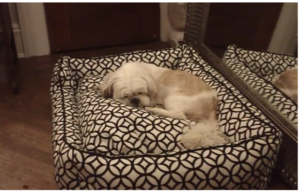
Crate training is a great way to keep your house and new puppy safe in it’s home. It is also an essential tool for house training and building up bladder control.
It takes puppies and dogs a little while to get used to crate training but using a boredom buster toys and treats help ease the process.
Introducing the Crate
Think of the crate as a studio apartment for your puppy. A studio apartment can be the worst place in the world if you have nothing to do in it. However, the same space filled with a flat screen tv, wifi, video games and pizza arriving every hour suddenly becomes the best place in the entire world! Now our job as “real estate” agents for crates is to make the space as appealing to our K9 clients as possible. We can use our dogs food, boredom buster toys and chew toys to make the crate a fun place to be.
Make the Crate a Palace
Start off by feeding your dog in the crate without locking the door. Start creating positive associations with the crate. If every meal and fun treat comes from inside the crate, Fido is going to start loving the idea of going in there. We love using food stuffed Kongs, bully sticks and flossies with our dogs undergoing crate training.

Don’t Isolate your Dog
A lot of people will make the mistake of setting up a crate in the corner of a room or in a closed bedroom (away from the family)and be surprised when Fido fusses. Start off having the crate next to you while you are watching TV, at your desk and next to your bed. Once Fido loves the crate at that proximity, start building up more and more distance.

Build Up Muscle
Think of “crate training” as being similar to “weight training”. Just like you are not going to be able to lift a 100lb weight on your first attempt, your puppy will not be able to tolerate 5 hours in the crate first time. However if you practice often, slowly and within your dogs comfort zone you will make fast progress and your dog will start to love being in his crate.

Always make the crate a positive place and avoid using it for punishment. Keep your expectations realistic and reward your dog when they have done a good job.
Good tips. Mr. N has crate anxiety so we just keep the crate open and reward him for going in when he does.
Great tips ~ I especially like the make the crate a palace one, its good to make it a comfortable space that’s not feared.
I crate trained my Lab puppy 6 years ago and I think it’s the most wonderful method. She never has an accident in the house since she was about 3-4 months old. Even during a fierce stomach virus last year, she would wake me up to put her out. It’s definitely intense for the owner the first few weeks, and you have to be watching and encouraging them all day, being very careful to only let them roam free in the house AFTER they have done their business (and then you still watch them), but the payoff is wonderful. And always, the second you let them out, put them straight in the yard! Then some (supervised) free roam indoors.
Great tips. Crates are wonderful when used for good!
I don’t have much experience with crate training because we have always adopted older dogs and some were already crate trained. I like these tips and especially the metaphor of crate training like weight training!
Ok this might sound crazy but till I got to the States I never knew what crate training was, as a kid growing up we never did and even now I know my family never has when rescuing dogs. I never did with Layla either, from day one I worked with her and she maybe had one or two accidents but she did them in the bathroom on the mat phew. In the 5 years that I have her I can count on one hand the accidents she has had, and I personally do not think I will ever do it. They are great tips but I personally do not believe in crates
I’ve spoken to many people about crate training, but they see it as a prison. Don’t worry I set them straight, but it really is such a handy tool. We got a crate for our 4ish year old dog Jack who had spinal surgery in August. He needed to keep still, and I expected a battle, never believing he would spend a second in it. Now I can barely get him out! When he’s in the house he stays in his crate and loves it. I keep the door open during the day, but close it at night and he’s as happy as anything.
Great tips on dog crate training. Crates can be so helpful in many ways. I love when dogs are comfortable in crates, you never know when they need to be confined.
For those who are crate training, this is very helpful. We never needed to go that route but if we did, this is spot on.
I love your anti-isolation tip. Dogs just want to be close to their people and always do better with stuff like this when the change is gradual. Great post!
I’ve always crate trained my dogs & my foster dogs. These are great tips. The only thing I’ll say it that although you want to ignore your dog’s crying and barking, don’t let them cry or back all night long. Excessive crying or barking means the dog is in distress. We made that mistake early on with my Husky when we brought her home as a puppy and I’ve regretted it ever since. As you suggest, I also should have situated the crate closer to us at night, not down the hall.
Love & Biscuits,
Dogs Luv Us and We Luv Them
The idea is that you should build your dog up to long periods of time, not just shove them in and hope the best (which so many people do).
When you are building up crate tolerance, you want to build up gradually over a period of time and ignore the barking during that period.The ideal situation is that you do this nice and slowly with plenty of boredom buster toys and treats (and a tired puppy) so you don’t even have to deal with barking. If your dog starts barking or howling, you must ignore it but you also know you have pushed your dog too far and the time needs to be reduced next time.
Hope that makes sense
My mom used crate training with her dog the first two years of his life. She doesn’t use it anymore because he knows his boundaries and has his own spot to relax.
Don’t do like my mom did, just put me in a crate and expect to sleep through the night! These tips are great and anyone with a new puppy should pay attention, I know! Love Dolly
Great article! I especially like that you made a point of having a lot of entertainment in the crate for the dog.
I like the ‘ignore the barking’ tip it should be front and centre. You must NOT weaken or you make a rod for your own back, and your dog will never behave in a crate again!AAGGHH That would lead to all kinds of stress and upsets!
It’s hard to do but it must be done
Great message and tips! I especially like how you likened the crate to a studio apartment and how to ensure the dog is entertained. I did not understand enough when I rescued Harley and failed miserably at crate training him. Wish I’d had your tips then!
Crate training isn’t easy. But we have to make it as easy as we can for our dogs
Informative post, i hope pet parents in India to take to the concept of crate training. As a canine Behaviorist – Trainer i have counselled my clients about the pros of having your dog crate trained
We crate trained Jack. We were told he his foster parents had been crate training him so we decided to continue. It is his ‘safe place.’ Henry and Reese are happier with full access to the house.
These are great tips for successful crate training. Our dogs don’t mind their crates and often go in them on their own.
Great Tips! All five of our Huskies have been crate trained, and they loved it! They had their own bedroom with a/c and a fan! To this day, two still love to run inside and nest all on their own, while two prefer to roam free.
These are great ideas. I love the idea of keeping the crate somewhere where the dog can see their family. I can imagine it is difficult for a dog (a natural pack animal) to know that life is going on in the other room without him/her.
The ignore barking step is what got us with Luna… She is a stubborn one and would bark all night long, so we eventually gave in. Now she sleeps in a crate in our bedroom with the door open. She still feels safe there, but doesn’t like being locked in.